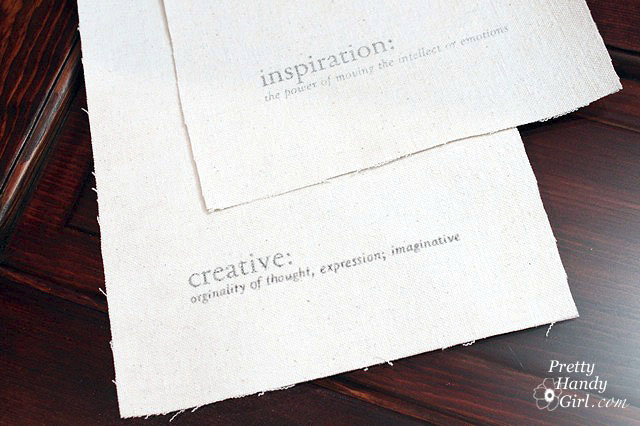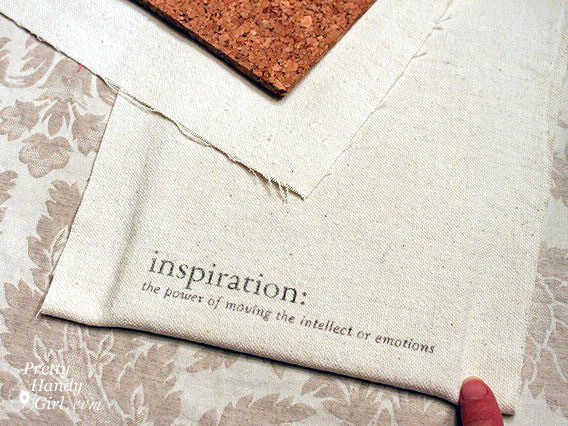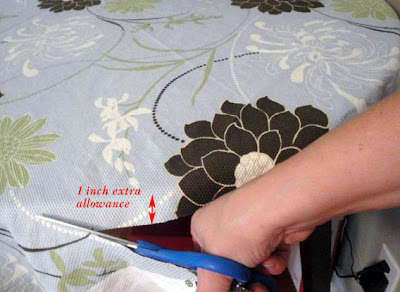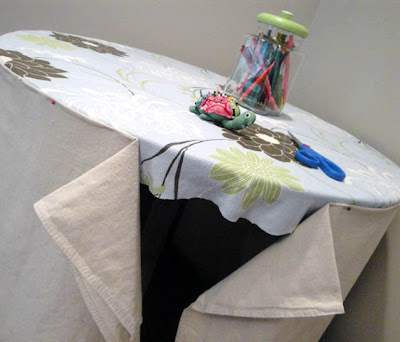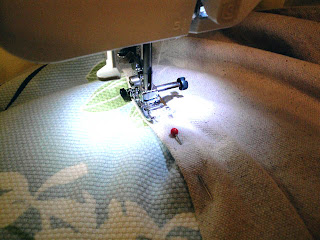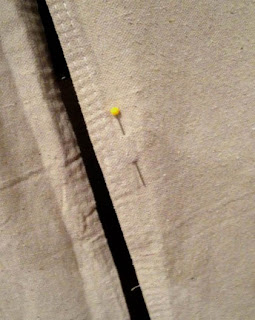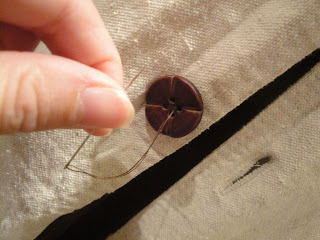Our office renovation is nearing completion. We’ve been working on the room for two plus months now. The majority of the work is complete, but we are waiting for two desk cabinets to come in to the Office Depot warehouse so we can actually order them. At this point I’m wondering if I should just build my own! <<Sigh>>
After searching for over a month on Craig’s List, I finally broke down and bought a small counter height bistro set from Big Lots for the corner of our office. We thought it would be a great place for the kids to sit and do homework. Or better yet, for Pretty Handsome Guy and I to talk and have our morning coffee!
The height and footprint is perfect, however, the dark wood (in addition to the other furniture in the room) made the room too dark for my taste. Okay – and I’m a sucker for hidden storage (need to hide that stop sign red box!) So, I came up with the idea to slipcover the table.
Unfortunately I didn’t have enough fabric left over from my yard sale re-upholstered chair and the back of the bookcase project. But, I did have enough to cover just the top of the table.
Then I bought two small 4′ x 5′ painter’s drop cloths for $5 each. I am seriously addicted to these must have fabrics! I already used a pair for our laundry room curtains and I bleached another one to make grain sack valances for our dining room at a later date.
So, anyone remember their geometry class? I barely remembered enough to figure out that the circumference of my 3′ diameter table is 9.42 (π x diameter or 3.14 x 3= 9.42). Therefore, two 5′ wide cloths would just cover my table!
The first thing I did was trim the fabric around the tabletop allowing a 1″ overage for seam allowance.
Then I ironed the drop cloths, and decorative table top fabric. I hate ironing – I hardly ever iron. Usually I’ll just spritz water on my shirts or pants in the morning and they dry wrinkle free. Or if it is really wrinkled, I will dampen my clothing and toss them in the dryer for a few minutes.
Sometimes, I just have to break out the iron. But, I found a way to make ironing enjoyable. I set up my ironing board and watched a little HGTV or DIY Network while I de-wrinkle. Nothing like a hot DIY hunk to make me all steamy. Hee, hee.
I folded the top of the drop cloths so they just meet the table top and the bottom brushes the floor (this way I won’t have to hem the bottom.) Next I pinned the 2 drop cloth pieces around the table. Being sure to use lots of pins, since sewing around a curve can have a tendency to make the fabric pucker.
Then I stitched on top of the drop cloth, as close to the edge as I could. Being careful to avoid letting the fabric pucker.
After a few trial and errors, I got a smooth line and the drop cloth edges overlapped slightly.
Next the fun part! Digging in my grandmother’s button tin! She passed this down to my mother and somehow it ended up in my possession. (Shhhh, don’t tell my sisters!) I love this tin. The smell I encounter when I open the tin is part metal, part perfume, and 100% nostalgia.
I remember the feeling of running my fingers through the buttons. Isn’t this the prettiest eye candy? All those colors and textures.
<<snap of the fingers>> Okay, back to the project at hand. I chose four large brown buttons. Then eye-balled them on my slipcover and put a pin where each one would be attached.
I used a disappearing pen to mark the size of the button on the side that overlaps the other.
This is the first time I’ve used the buttonhole foot on my Brother CS-6000i sewing machine. (No, I’m not paid to endorse this sewing machine. I just can’t believe all the features it has for the $125 price!) I was impressed by the button holder that automatically tells the machine how big to make the hole.
The machine also has a feature where it can stitch your buttons on, but I knew it would take me longer to read and measure how to tell my machine where the holes in the buttons were. So, I sewed them on by hand.
And presto, I have a pretty bistro table with storage underneath!
And, a place to have morning coffee with Pretty Handsome Guy.
And, somewhere for the kids to do homework (or brush up on reading at
Starfall.com.)
















